The Apple iPhone 6s and iPhone 6s Plus Review
by Ryan Smith & Joshua Ho on November 2, 2015 8:00 AM EST- Posted in
- Smartphones
- Apple
- Mobile
- SoCs
- iPhone 6s
- iPhone 6s Plus
Battery Life
With any smartphone, battery life is always one of the most important considerations. It probably goes without saying that more battery life is always better. In the case of the iPhone 6s, battery life is especially important to examine because this year Apple has actually made the battery of their phone smaller than before. Normally, it’s almost a given that battery size will be at least constant or increase but in order to accommodate additional components like the Taptic engine the battery has been made smaller. In light of this reversal one might assume that battery life has decreased as a result, but given the move to a FinFET process and other major component improvements it’s hard to say how battery life has increased or decreased. In order to test this properly, we ran the iPhone 6s’ through our suite of battery life tests to try and get an idea for overall battery life. As always, we run all battery life tests with the display set to an average of 200 nits and all possible background tasks disabled.
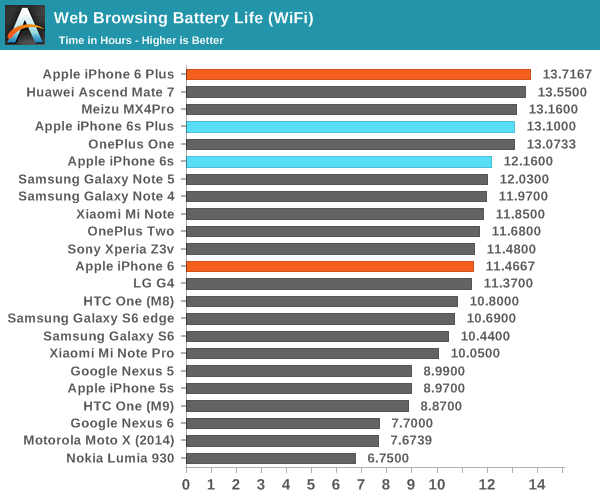
Our first test is WiFi web browsing, and here we see a pretty curious trend. The iPhone 6s Plus appears to regress relative to the iPhone 6 Plus, yet the iPhone 6s solidly beats the iPhone 6. I was pretty confused by this, but it’s likely that we’re seeing these results because the iPhone 6s is going to have larger relative power consumption of the SoC when compared to the display. As the display becomes bigger, the effects of SoC efficiency are just harder to notice, which also explains why it looks like the iPad Air 2 has effectively the same battery life whether you’re running just a blank display or our web browsing test. Both of our review units use a TSMC A9, so I don’t think we can attribute a foundry difference to the odd results that we’re seeing here.
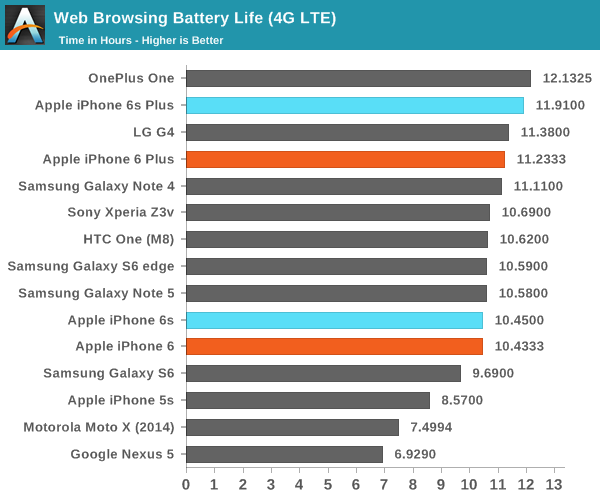
In LTE web browsing, we see a smaller improvement than what we observed in the WiFi test. This might seem strange, but given that the move from a 28nm process to a 20nm process on the modem from iPhone 6 to 6s didn’t come with FinFET it makes sense that the modem will remain a significant power drain. It’s likely that the next big jump in battery life here will come with FinFET process technology on the modem, along with other general modem design improvements.
In order to also look at battery life in more extreme scenarios, we use Basemark OS II and GFXBench to really place a strong stress on the CPU and GPU to see what power draw is like under sustained load. This also allows us to see the extent to which various components of the phone throttle down in response to relatively high sustained loads. However, it’s important to note that the Basemark OS II performance score here isn’t necessarily as accurate as scores from Android devices as the battery score can be calculated with 98 data points instead of 80 as battery score is partially derived from the rate at which the battery percentage decreases. It's also worth noting that in GFXBench there are two data points removed as the low power popup causes an incorrect frame rate to be recorded.
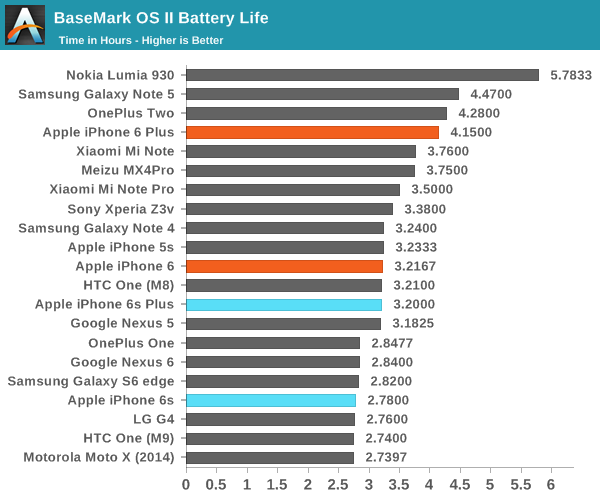
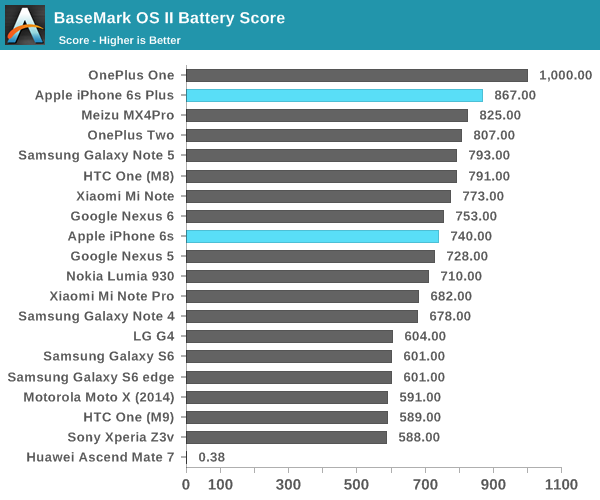
In Basemark OS II, we start off with a pretty shocking result as the iPhone 6s lasts less than three hours in this test, but looking at the battery score it’s pretty clear that the reason why the iPhone 6s doesn't last very long is because it’s running with relatively little throttling throughout the test, so the battery score is high as a result. The same is true of the iPhone 6s Plus, but the larger battery helps it to last a bit longer.
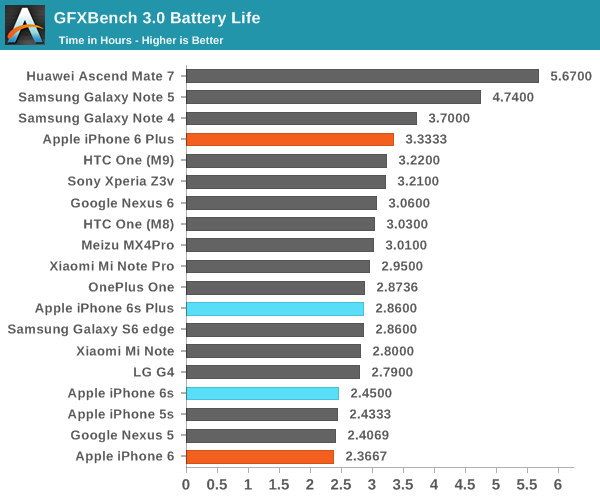
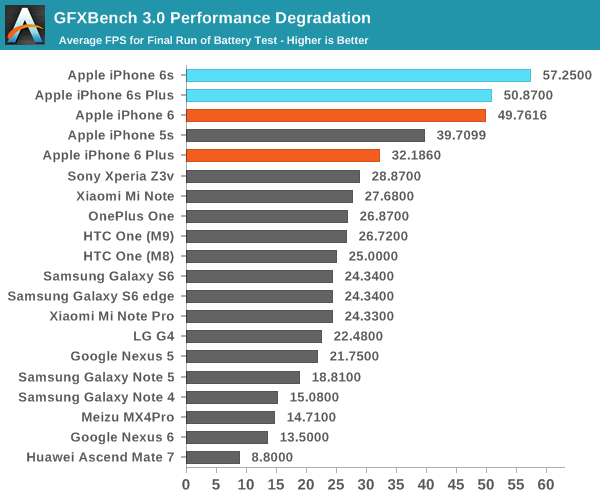
Looking at GFXBench, which is an infinite loop of the T-Rex on-screen benchmark to approximate intensive video gaming we see that the iPhone 6s doesn’t last very long either, but the performance throughout the test is incredible. Due to 1334x750 display resolution and strong GPU, the iPhone 6s manages to last the entire test without any notable throttling, and effectively pegged at the refresh rate of the display. The iPhone 6s Plus manages a similar level of performance but over time you can start to see some throttling, likely a function of the longer runtime and higher display resolution. It’s interesting to see how in the space of two years just how much progress has been made here in terms of improving GPU performance and efficiency, as when we first ran this test it was probably one of the most stressful tests out there for any smartphone or tablet.
Charge Time
Of course, while battery life is usually the main determinant of overall mobility it’s often important to consider charge time. A phone that charges slowly can be much less mobile than another phone, even if it has better battery life. In the case of the iPhone 6s’, it seems that Apple continues to ship the standard 5W charger that they have for many generations in the smartphone industry. In order to see how this charger and phone combination performs, we use our usual methods of timing the phone from fully discharged to fully charged.
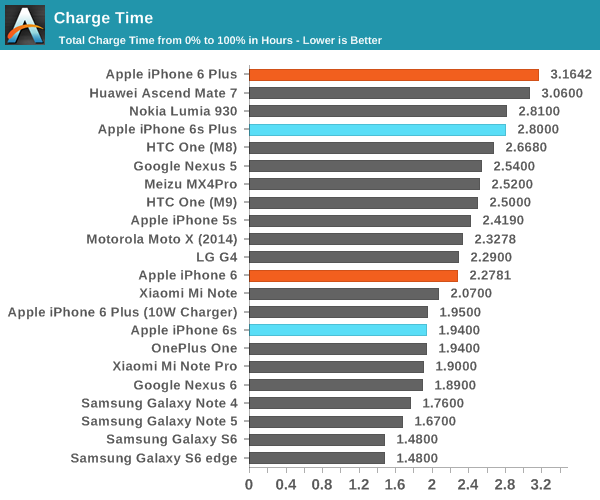
Here, the iPhone 6s and 6s Plus both show a decent improvement over the iPhone 6 and 6 Plus, but not enough to make an significant difference. The iPhone 6s charges at a pretty reasonable rate, but the iPhone 6s Plus really does need a more powerful charger than it does now. You can use an iPad charger to bring things back up to speed but getting this means that you either have to have an iPad already or you have to go out and buy an iPad charger, which is on the annoying side when Android OEMs generally include fast chargers in the box.




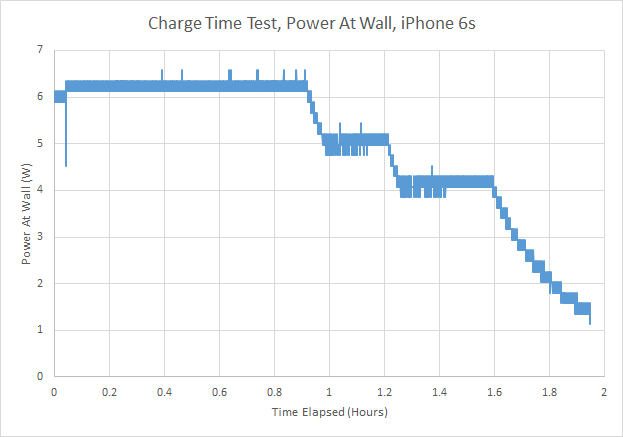
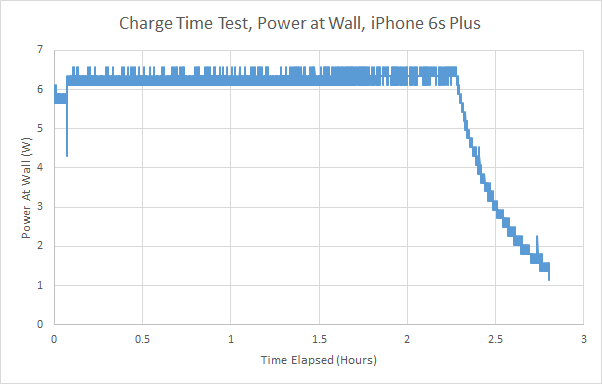








531 Comments
View All Comments
Mummiez - Saturday, December 26, 2015 - link
There is also a video on YouTube showing a dancing man wearing a horse mask. Even more amusingly, I must add.https://www.youtube.com/watch?v=ffDPTKn7HiY
mike3332015 - Saturday, November 7, 2015 - link
if this gets the second highest award then can someone tell me what got the first highest award?TechnologyGuy - Saturday, November 7, 2015 - link
Good review but as many have pointed out, as is customary at Anand, very biased in favor of Apple products. Over-reaching statements are used throughout the article and the conclusions simply don't follow from the evidence. No doubt the 6s is one of the top smartphones on today's market but it lags in camera performance (Z5, S6, G4, P6 are all better) and the poor screen is simply unacceptable by today's standards (no, the dpi is high enough argument holds no water; at least for me I can tell at a first glance when compared to other phones). Software is of course more subjective and for normal usage, there is no clear winner between iOS and Android. Stability is non-argument as I have had far more issues on my iPhones than my Galaxy S6, not to mention having to fix my GF's phone after iOS 9 bricked it. Lack of customization in iOS (short of jailbreaking which is still limiting) is also a deal-breaker for those of us who care.So is it a good phone? Sure I'd agree. But it's far from the leaders in the market today and to claim such is simply false.
ciderrules - Saturday, November 7, 2015 - link
Yet another person upset at the cold, hard, fact that Apple is killing it with fantastic hardware.TechnologyGuy - Sunday, November 8, 2015 - link
Fantastic hardware? I guess you didn't even read my comment. The SoC is a very nice engineering achievement but it does nothing to alter my user experience as a power user. The features I personally require are simply subpar in today's flagship market (camera & screen as I have clearly pointed out).There is nothing to be upset about - Apple has come up with a very nice product that fits well into the top end of the market but there is no question it misses the mark in several areas, at least for users like myself. I am more disappointed in the biased nature of the review than the actual product.
ciderrules - Sunday, November 8, 2015 - link
Power user? iOS users are the true power users as they actually can choose from high-end software to do real work on their devices. Or do you think widgets or minor customization makes you a power user?Oh, and saying Anand is biased? Typical response from people who dislike Apple and are having trouble trying to accept they make the best smartphone.
TechnologyGuy - Monday, November 9, 2015 - link
Why would I accept that Apple makes the best smartphone when the company does not? Blind favoritism serves no purpose in the tech world. For that matter, I do not think any company makes the "best" products. Such a term is irrelevant and frankly counter productive. I expect Anand and its readers to be more discerning than that. Or perhaps I am wrong.I have owned and still own several Apple products. Are they definitively superior to their competitors? No, they are not, but they serve their purpose, as any adequate or premium technology product should.
I have no doubt that some developers have chosen the iOS ecosystem for specialized applications; however, those are not relevant to my needs. As I pointed out very clearly, I have very specific requirements which the iPhone 6s has not met. I am simply pointing out the biases in this review. If it meets your needs, great, then I guess you are one happy customer.
As a former computer/electrical engineer who specialized in signal processing, I need no one to tell me a what a power user is, nor would I be inclined to respond further unless there is some valid, well-constructed points to be discussed.
Samus - Saturday, November 7, 2015 - link
11MB cache on a mobile SOC? Damn!?zeeBomb - Sunday, November 8, 2015 - link
Damnnnn!Zoidberg - Saturday, November 7, 2015 - link
Even for AT this is laughable... no mention of the fact that Plus is 25% heavier with a smaller screen and battery than Edge+. Fanboys or sellouts?